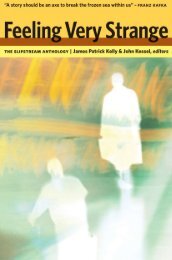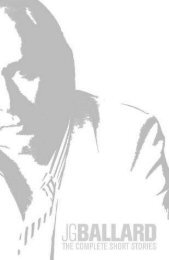The Curse of the Wer.. - Site de Thomas - Free
The Curse of the Wer.. - Site de Thomas - Free
The Curse of the Wer.. - Site de Thomas - Free
You also want an ePaper? Increase the reach of your titles
YUMPU automatically turns print PDFs into web optimized ePapers that Google loves.
SHIFTING SHAPES OF THE WEREWOLF<br />
proliferation <strong>of</strong> explanations for lycanthropy that circulated in <strong>the</strong><br />
nineteenth century.<br />
In mo<strong>de</strong>rnity, <strong>the</strong> werewolf has also been uniquely implicated in<br />
elaborating ways <strong>of</strong> thinking about selfhood. A distinct focus on <strong>the</strong><br />
self (or subject) emerged with <strong>the</strong> Enlightenment, through <strong>the</strong> new emphasis<br />
on human ra<strong>the</strong>r than divine agency, <strong>of</strong>ten termed ‘humanism’.<br />
Enlightenment philosophy emphasized selfhood as a project that could<br />
be directed through <strong>the</strong> conscious exercise <strong>of</strong> reason and morality, and<br />
in this sense projected a vision <strong>of</strong> an i<strong>de</strong>al or ‘universal’ subject. This<br />
vision was predicated, however, upon <strong>the</strong> conceptual separation <strong>of</strong><br />
‘body’ and ‘mind’, sometimes referred to as ‘Cartesian dualism’ after<br />
<strong>the</strong> philosopher René Descartes, whose famous statement Cogito ergo<br />
sum — traditionally translated as ‘I think, <strong>the</strong>refore I am’ — suggested<br />
such a separation. This conceptualization <strong>of</strong> <strong>the</strong> self was reinforced and<br />
elaborated within Enlightenment philosophy through fur<strong>the</strong>r, parallel,<br />
oppositions: particularly that <strong>of</strong> nature–culture.<br />
<strong>The</strong> wolf has long been associated with nature in Western thought;<br />
as Barry Lopez remarks, ‘What men [sic] said about one, <strong>the</strong>y generally<br />
meant about <strong>the</strong> o<strong>the</strong>r.’ 1 Accordingly, <strong>the</strong> symbiosis <strong>of</strong> human<br />
and wolf in <strong>the</strong> figure <strong>of</strong> <strong>the</strong> werewolf has presented <strong>the</strong> opposition<br />
<strong>of</strong> nature (represented by <strong>the</strong> wolf) and culture (represented by <strong>the</strong><br />
human) in potent terms; terms that were fur<strong>the</strong>r <strong>de</strong>veloped in <strong>the</strong><br />
romantic period, which witnessed <strong>the</strong> emergence <strong>of</strong> a subjectivity<br />
imaged through an internal–external or <strong>de</strong>pth–surface duality. This<br />
spatialization <strong>of</strong> subjectivity resonated with <strong>the</strong> human exterior–lupine<br />
interior (or vice versa) imagery <strong>of</strong> <strong>the</strong> werewolf, and has been one <strong>of</strong><br />
<strong>the</strong> lasting legacies <strong>of</strong> romanticism. Building on such visualizations <strong>of</strong><br />
<strong>the</strong> ‘divi<strong>de</strong>d’ self, representations <strong>of</strong> lycanthropy have also been consistently<br />
conceptualised around <strong>the</strong> related poles <strong>of</strong> civilized–primitive,<br />
rational–instinctual, public–private and masculine–feminine. In this<br />
sense, <strong>the</strong> werewolf has mo<strong>de</strong>lled <strong>the</strong> dualistic subjectivity that emerged<br />
through <strong>the</strong> Enlightenment in graphic, exaggerated — or monstrous<br />
— terms. Yet, as Slavoj Žižek has argued <strong>of</strong> monsters more generally,<br />
<strong>the</strong> werewolf also appears as a bridge between nature and culture, by<br />
exceeding both categories and representing slippages between <strong>the</strong>m.<br />
3





